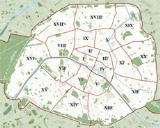
Rue Mouffetard, Paris
Encyclopedia
Rue Mouffetard is a street in the 5th arrondissement of Paris
, France
.
Situated in the fifth (cinquième) arrondissement of Paris, Rue Mouffetard is one of Paris's oldest and liveliest neighbourhoods. These days the area has many restaurants, shops, and cafés, and a regular open market. It is centered on the Place Contrescarpe, at the junction of the rue Mouffetard and the rue de Lacepede. Its southern terminus is at the Square Saint-Médard where there is a permanent open-air market. At its northern terminus, it becomes the rue Descartes at the crossing of the rue Thouin. It is closed to normal motor traffic much of the week, and is predominantly a pedestrian avenue.
times. As with today's rue Galande, rue Lagrange, rue de la Montagne Sainte-Geneviève
and rue Descartes, it was a Roman road running from the Roman Rive Gauche
city south to Italy.
From the Middle Ages
a church along this section of roadway became centre of a "bourg Saint-Médard" (Saint-Médard village), and from 1724 was integrated into Paris as the main artery of the "Faubourg Saint Médard".
The area remained relatively unchanged because of its location on the Saint Geneviève hill
, which protected it from Baron Haussmann
's redevelopment during the reign of Napoleon III
.
's Trois Couleurs: Bleu (1992).
Paris
Paris is the capital and largest city in France, situated on the river Seine, in northern France, at the heart of the Île-de-France region...
, France
France
The French Republic , The French Republic , The French Republic , (commonly known as France , is a unitary semi-presidential republic in Western Europe with several overseas territories and islands located on other continents and in the Indian, Pacific, and Atlantic oceans. Metropolitan France...
.
Situated in the fifth (cinquième) arrondissement of Paris, Rue Mouffetard is one of Paris's oldest and liveliest neighbourhoods. These days the area has many restaurants, shops, and cafés, and a regular open market. It is centered on the Place Contrescarpe, at the junction of the rue Mouffetard and the rue de Lacepede. Its southern terminus is at the Square Saint-Médard where there is a permanent open-air market. At its northern terminus, it becomes the rue Descartes at the crossing of the rue Thouin. It is closed to normal motor traffic much of the week, and is predominantly a pedestrian avenue.
Origin of the name
The rue Mouffetard runs along a flank of the mont Sainte-Geneviève hill that was called "mont Cétarius" or "mont Cetardus" from Roman times : many historians consider "Mouffetard" to be a derivation of this early name. Over the centuries the rue Mouffetard has appeared as rue Montfétard, Maufetard, Mofetard, Moufetard, Mouflard, Moufetard, Moftard, Mostard, and also rue Saint-Marcel, rue du Faubourg Saint-Marceau ("street of the suburb Saint-Marceau") and rue de la Vieille Ville Saint-Marcel ("street of the Old Village Saint-Marcel").History
The origins of this thoroughfare are ancient, dating back to NeolithicNeolithic
The Neolithic Age, Era, or Period, or New Stone Age, was a period in the development of human technology, beginning about 9500 BC in some parts of the Middle East, and later in other parts of the world. It is traditionally considered as the last part of the Stone Age...
times. As with today's rue Galande, rue Lagrange, rue de la Montagne Sainte-Geneviève
Montagne Sainte-Geneviève
The Montagne Sainte-Geneviève is a hill on the left Bank of the Seine in the 5th arrondissement of Paris.On the top of the Montagne, one can visit the Panthéon or the Bibliothèque Sainte-Geneviève, which is often full of students from La Sorbonne and other nearby universities...
and rue Descartes, it was a Roman road running from the Roman Rive Gauche
Rive Gauche
La Rive Gauche is the southern bank of the river Seine in Paris. Here the river flows roughly westward, cutting the city in two: looking downstream, the southern bank is to the left, and the northern bank is to the right....
city south to Italy.
From the Middle Ages
Middle Ages
The Middle Ages is a periodization of European history from the 5th century to the 15th century. The Middle Ages follows the fall of the Western Roman Empire in 476 and precedes the Early Modern Era. It is the middle period of a three-period division of Western history: Classic, Medieval and Modern...
a church along this section of roadway became centre of a "bourg Saint-Médard" (Saint-Médard village), and from 1724 was integrated into Paris as the main artery of the "Faubourg Saint Médard".
The area remained relatively unchanged because of its location on the Saint Geneviève hill
Montagne Sainte-Geneviève
The Montagne Sainte-Geneviève is a hill on the left Bank of the Seine in the 5th arrondissement of Paris.On the top of the Montagne, one can visit the Panthéon or the Bibliothèque Sainte-Geneviève, which is often full of students from La Sorbonne and other nearby universities...
, which protected it from Baron Haussmann
Baron Haussmann
Georges-Eugène Haussmann, commonly known as Baron Haussmann , was a French civic planner whose name is associated with the rebuilding of Paris...
's redevelopment during the reign of Napoleon III
Napoleon III of France
Louis-Napoléon Bonaparte was the President of the French Second Republic and as Napoleon III, the ruler of the Second French Empire. He was the nephew and heir of Napoleon I, christened as Charles Louis Napoléon Bonaparte...
.
Cultural references
The area and the street featured prominently in Krzysztof KieślowskiKrzysztof Kieslowski
Krzysztof Kieślowski was an Academy Award nominated influential Polish film director and screenwriter, known internationally for The Double Life of Veronique and his film cycles The Decalogue and Three Colors.-Early life:...
's Trois Couleurs: Bleu (1992).

